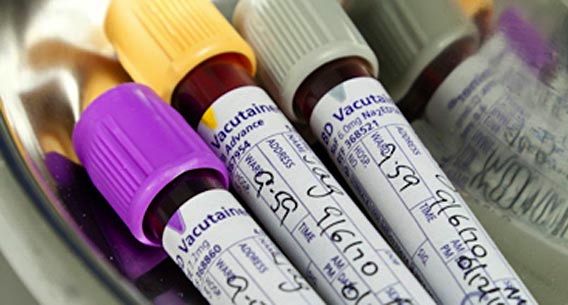Cyrex Testing: What you need to know
The Cyrex Tests are available to order through our clinic. These immunological tests are recommended for people concerned about intestinal permeability, gut health, gluten sensitivity, cross reactions to foods, antibody assessments, blood brain barrier health and sensitivities to chemicals. They can be ordered as individual panels or combined. Cyrex is the leading laboratory in immunological testing and validity of tests are supported by published research.
If you are unsure as to which tests are appropriate for you please ring our clinic for FREE advice. A 1 hour consultation is included in the costs for the tests to help you interpret the results.
Array 1: Gluten Sensitivity Screen (oral fluid sample)
What it measures: Secretory IgA, Gliadin IgA + IgM, Transglutaminase IgA + IgM
When to use this test: a non-invasive method for the identification of gluten reactivity useful when there is a family history of coeliac disease and / or for young children. The inclusion of IgM covers the mucosal immune reaction against these antigens in IgA deficient patients. This test can identify gluten reactivity before villous atrophy is present (1). If positive, array 3 is recommended for a more comprehensive assessment.
Array 2: Intestinal Antigenic Permeability Screen
What it measures: Actomyosin IgG, Occludin/Zonulin IgG, Occludin/Zonulin IgA, Occludin/Zonulin IgM, Lipopolysaccharides (LPS) IgG, Lipopolysaccharides (LPS) IgA, Lipopolysaccharides (LPS) IgM.
Intestinal permeability can cause systemic inflammation, which can then sustain itself by its ongoing effect on the gut. This array assesses gut barrier damage by measuring antibodies to barrier proteins. It can therefore detect barrier damage long before there is dysregulation in absorptive function. This makes it very different from the Lactulose/Mannitol test, which was originally designed to be an assessment of nutrient absorption not intestinal permeability. The Intestinal Antigenic Permeability Screen identifies an immune response indicating damage to the intestinal mucosal microstructures, including the epithelial cell network and the intercellular tight junctions. It does this by identifying antibodies against the tight junction proteins (occludin and zonulin) and antibodies to the actomyosin network (a protein complex that regulates intestinal barrier function by maintaining the plasticity of tight junctions). It also measures an immune response to lipopolysaccharides, which can be involved in the initiation and/or perpetuation of chronic, systemic inflammation.
When to use this test: Consider this test for clients with suspected food allergies, gluten sensitivity, inflammatory bowel disease, autoimmune diseases, family history of autoimmune disease, neurological conditions (Multiple sclerosis) or problems with cognitive function, (depression, anxiety, schizophrenia)
Array 3: Wheat/Gluten Proteome Sensitivity & Autoimmunity
What it measures: This is the most comprehensive wheat and gluten sensitivity panel available. It includes measurement of IgA and IgG against multiple gluten and wheat epitopes. Standard serological testing only includes serum IgG and IgA against gliadin and tissue transglutaminase-2 (tTG2). These antibodies are measured against minor components of a wheat protein called alpha-gliadin. However, wheat consists of multiple proteins and peptides including, alpha-gliadin, omega-gliadin, glutenin, gluteomorphin, prodynorphin, and agglutinins. Any of these antigens has a capacity to challenge the immune system. This array also includes opioid peptides, which have been linked to symptoms such as ‘brain fog’, behavioural problems, mood swings, depression, or other neurological complaints. It identifies wheat germ agglutinins (WGAs), lectins that can bind to cells involved in the immune system and induce toxic damage, inflammation, and autoimmunity. It also includes various tissue transglutaminases, which indicate tissue damage to various tissues in the body including neural tissue
When to use this test: This test is recommended for clients who you suspect have intestinal mucosal damage, complain of wheat or gluten allergy and/or intolerance. Consider this test for clients who present multiple-symptom complaints (including Chronic Fatigue Syndrome and Fibromyalgia), Suffer from abnormal immune cell count and function, or who may suffer from blood-brain barrier permeability, neurological conditions, depression, or any autoimmune condition (e.g thyroiditis, arthritis, myocarditis, dermatitis). Gluten needs to be consumed for this test to be accurate
Array 4: Gluten-Associated Sensitivity & Cross-Reactive Foods
What it measures: IgG and IgA combined to a range of foods some are known to cross react with gluten (1, 2). Other foods tested are common allergens or foods commonly over consumed on a gluten free diet, which may lead to sensitivity. The foods include dairy, milk chocolate, sesame, hemp, rye, barley, buckwheat, sorghum, millet, spelt, amaranth, quinoa, yeast, oats, egg, soy, tapioca, corn, coffee, rice and potato.
When to use this test: Consider this test for clients on a gluten free diet, who are gluten sensitive or coeliac and still don’t feel well despite following a gluten free diet. This is also suitable for clients who have an autoimmune disease, or have intestinal permeability, which does not appear to be improving despite treatment. If the client is gluten sensitive and cross-reactive foods are identified these will need to be avoided for life in same way as gluten. If any of the foods commonly consumed on a gluten free diet show positive, the offending foods should be eliminated from the diet while the gut is healed. These foods may be able to be reintroduced on a rotation basis and the test re-run to check for any further reaction.
Arrays 5 Multiple Autoimmunity Reactivity Screen; arrays 6, 7, 7x, 8 Specific Autoimmunity Reactivity Screens.
What these arrays measure: Array 5 measures IgG and IgA to 24 different tissues in the body detecting the presence of autoantibodies. Arrays 6,7,7X and 8 focus on particular organs, tissues or disease conditions. The detection of autoantibodies is the first step in the detection of autoimmune conditions. Antibodies can be present in the body many years before signs and symptoms of the disease or diagnosis is made. Early detection before extensive tissue damage would allow a window of opportunity to address and arrest and even in some cases reverse the autoimmune condition.
When to use this test: For clients with any idiopathic condition, gluten sensitivity / coeliac disease, chronic intestinal permeability, diagnosed with an autoimmune condition or chronic toxin exposure. It is important to note that this is not a test to diagnose any condition but to identify the present of autoantibodies to body tissues. On detection of autoantibodies a referral may be required.
Array 11: Chemical Immune Reactivity Screen
What it measures: This panel looks at toxins from a biological source (aflatoxins) and toxicants from human-made sources (BPA, heavy metals, mercury compounds, formaldehyde, parabens, benzene ring compounds etc.). Rather than looking at levels of these compounds (e.g through urine hair, blood etc.) in the body it is measuring antibodies to these chemicals bound to tissue. Two people may have the same exposure to a particular chemical and one will not be affected while the other can have significant health consequences from it. The presence of these antibodies indicates not only exposure to these compounds but loss of tolerance and a body burden of chemical exposure, which may trigger an autoimmune reactivity.
When to consider this test: This test can be particularly useful for clients exposed to toxicants on a regular basis, clients suffering with an autoimmune condition or show an abnormal immune response, intestinal permeability and for clients with increased chemical sensitivities.
Array 20: Blood Brain Barrier
What it measures. The blood brain barrier (BBB) is a physical barrier formed by the arrangement of endothelial cells and tight junctions that line the capillaries, which supply blood to the brain. This test measures blood brain barrier protein (IgA & IgG combined and IgM). Breach of the blood brain barrier can arise due to traumatic head injuries, stress, inflammation and/ or environmental triggers such as toxicants, foods and pathogens. Due to cross-reactivity between environmental triggers and neurological tissues, patients with circulating antibodies to known environmental triggers who experience BBB breakage, are at risk for those environmental antibodies infiltrating the brain and causing neurological tissue damage (4). For example a gluten reactive patient continues to consume gluten and has BBB permeability, the circulating gliadin antibodies can enter the nervous system and attack the tissues to which gliadin cross-reacts. The patient’s immune system will produce autoantibodies against the neurological tissues, which will cause further damage leading to neuroautoimmunity. Similar cross reactivity can occur with microbial infections.
When to consider this test: BBB permeability has been linked to various conditions including Parkinson’s disease, Sarcoidosis, Traumatic brain injury, Multiple sclerosis, Alzheimer’s disease and Autism. Consider this test for clients who play contact sports or activities in which repeated head trauma occurs, have intestinal permeability or exhibit changes in cognitive function.
If you are interested in ordering any of these tests please contact our clinic for details
References
(1) Bonamico M et al. First salivary screening of celiac disease by detection of anti-transglutaminase autoantibody radioimmunoassay in 5000 Italian primary school children. J Pediatr Gastroenterol Nutr, 2011; 52(1):17-20.
(2)Vojdani A et al. Immune response to dietary proteins, gliadin and cerebellar peptides in children with autism. Nutritional Neuroscience, 2004, 7(3):151-161.
(3)Alaedini A et al. Immune cross-reactivity in celiac disease: anti-gliadin antibodies bind to neuronal synapsin I. J Immunol, 2007; 178:6590-6595.
(4) Zoikovic B (2008) The blood brain barrier in health and chronic diseases Neuron, Volume 57, Issue 2, 178-201, 24 January 2008

